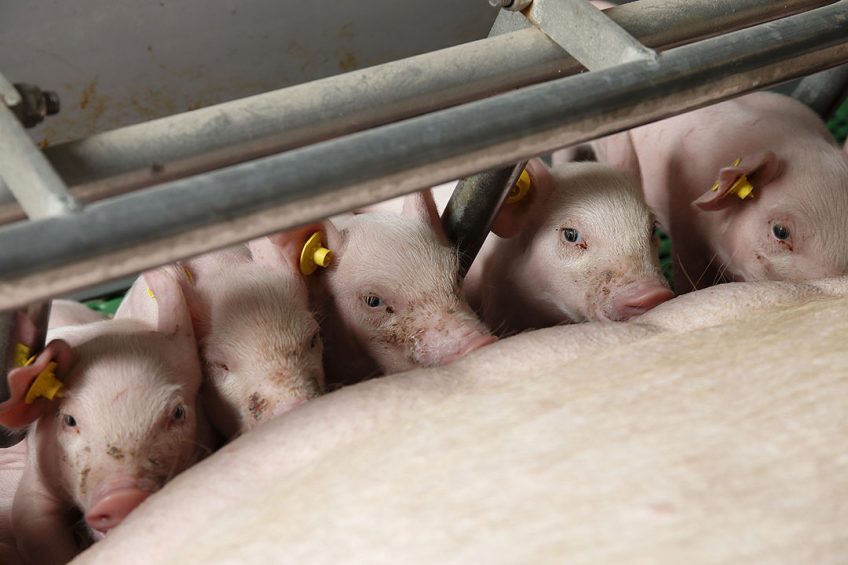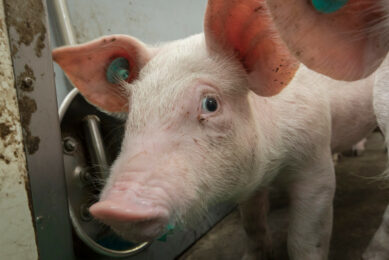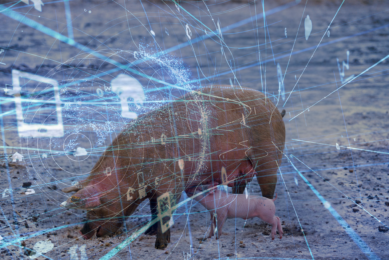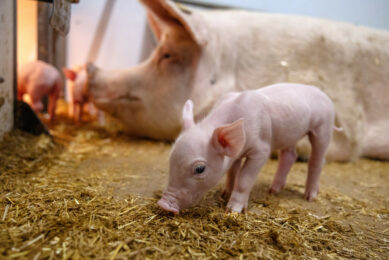A new boost of oxygen to sow productivity

Numbers of piglets per litter continue to grow from year to year. Yet it is also known that the more piglets born per litter, the longer the farrowing duration and greater the risk of stillbirths. Is there a way to make farrowing easier for sows and piglets?
The selection for increased litter size is strategic for improving pig production efficiency. However, larger litters means longer farrowing, leading to higher risk of stillbirth and decreased piglet vitality. High piglet vitality is crucial to significantly decrease pre-weaning mortality. Vital piglets are more likely to receive enough energy through colostrum. This leads to a reduction of mortality due to crushing or hypothermia.
Strong uterine contractions at farrowing can cause high pressure on the piglets in utero, as well as on the placenta and the umbilical cord. This directly leads to reduced blood flow, which can be aggravated through umbilical cord ruptures or placenta detachment. When severe enough, the lack of oxygen can induce a higher number of stillbirths or lower piglet vitality at birth. This results again in higher pre-weaning mortality.

Figures 1A and 1B show the partial CO2 and O2 pressure as well as lactate values of umbilical cord blood samples from piglets that either died at birth or survived until weaning. Results show that live-born piglets suffering hypoxia during their journey through the birth canal have more CO2 and lactate in their blood at birth and a higher likelihood of dying before weaning. In short, how a piglet is born determines its chances of pre-weaning survival.
How farrowing duration is increased
Research carried out by Cargill in the Netherlands estimates that, per piglet added to a litter, farrowing duration will increase by about ten minutes leading to an increase of 0.8% in incidence of stillbirth and a 1.7% increase in incidence of mortality. Nutrition is one of many factors, besides litter size, affecting the duration of farrowing. Little is known about how much energy is required by the sow for farrowing, but it is likely comparable to heavy physical exercise.

At the same time, sows are often left without feed for the several hours before farrowing. Recent work carried out by Takele Feyera at Aarhus University, Denmark, showed that the longer the time between the last meal of a sow and the onset of farrowing, the lower the glucose level in sow bloo, and the longer the duration of farrowing. Stillbirth increased significantly when the time between the last meal and the onset of farrowing exceeded six hours.
Most farms feed sows a lactation diet and restrict feed distribution around farrowing to prevent udder oedema and constipation and to ensure a high intake post farrowing. In practice, farrowing sows are given a feed to produce milk, not to help the birth process. Is there a way to better support the farrowing sow though specific sow nutrition?

 Heavy physical exercise
Heavy physical exercise
Cargill researchers were inspired by technologies used in human sports nutrition, in particular those used to help athletes prepare for heavy physical exercise such as a marathon. This resulted in a new nutritional concept for sow feed, called LivaPig. This concept is formulated to increase the level of nitric oxide (NO) in sow blood, which in turn can support an increased number and diameter of blood vessels. As for athletes, ensuring a larger blood flow reduces muscle acidification, in turn supporting endurance in physical effort. More blood flow also means carrying more oxygen and nutrients in utero to the piglets during farrowing. The advantage of the technology is that NO formation in blood works even at low oxygen pressure and is enhanced at a lower pH. Those conditions are typical during farrowing, when oxygen levels in tissue are low and acidification of muscles occurs.
A research trial carried out in the Netherlands found that sows supplemented with this feed concept from seven days before farrowing onwards had reduced piglet losses during lactation when compared to the control group. This could be explained by heavier birth weights, larger placental sizes, higher vitality scores and improved oxygen levels in the umbilical cord blood right after birth (Figures 3A and 3B).

Further evaluation by pig producers
The concept was evaluated further in practice by pig producers. In 2018 and 2019, more than 13 trials were carried out on commercial farms across Europe, using a total of 4,500 sows with a productivity level of up to 19 piglets born per litter.
On average, sows supplemented with this feed concept required less farrowing assistance and gave birth to heavier piglets. Piglet livability improved by 3% (see Figure 4). Those observations suggest that the sow feed concept could do more than just support sows through farrowing. In the majority of the test farms, piglets were more than 500 grammes heavier at weaning when fed by sows receiving the supplement during lactation.
These higher weaning weights could be explained in two ways:
- A direct effect of the higher birth weights and vitality of piglets; and
- An improved blood and nutrient flow to the udder during lactation, leading to a potentially higher milk yield, as suggested by S.W. Kim and others at North Carolina State University, USA, in 2009, from a similar experiment using NO precursors.
Feeding to farrow
In conclusion, it is important to feed highly productive sows not only to produce milk, but also to farrow. Increasing the supply of oxygen and nutrients, by supplementing LivaPig trough sow diets, to reproductive tissues and piglets in utero will lead to higher piglet livability and litter weights at weaning. In a 1,000 head sow farm, this higher sow productivity is equivalent to more than 1,200 additional piglets per year.

Another way to look at sow productivity is through its benefits to greenhouse gas emissions. Using the sow feed concept allows the same output to be obtained as on a 1,000 sow farm, with 28 sows fewer. This reduces the environmental footprint by 17.5 tonnes of CO2 equivalent per year. Moreover, higher livability means improved piglet welfare. These are important outcomes to support in sustainable pork production.
References available upon request











